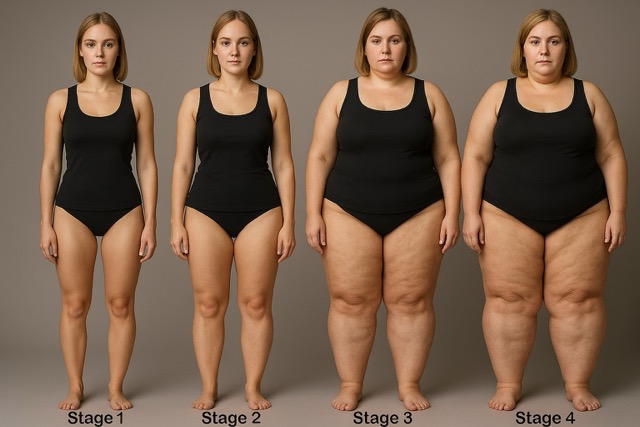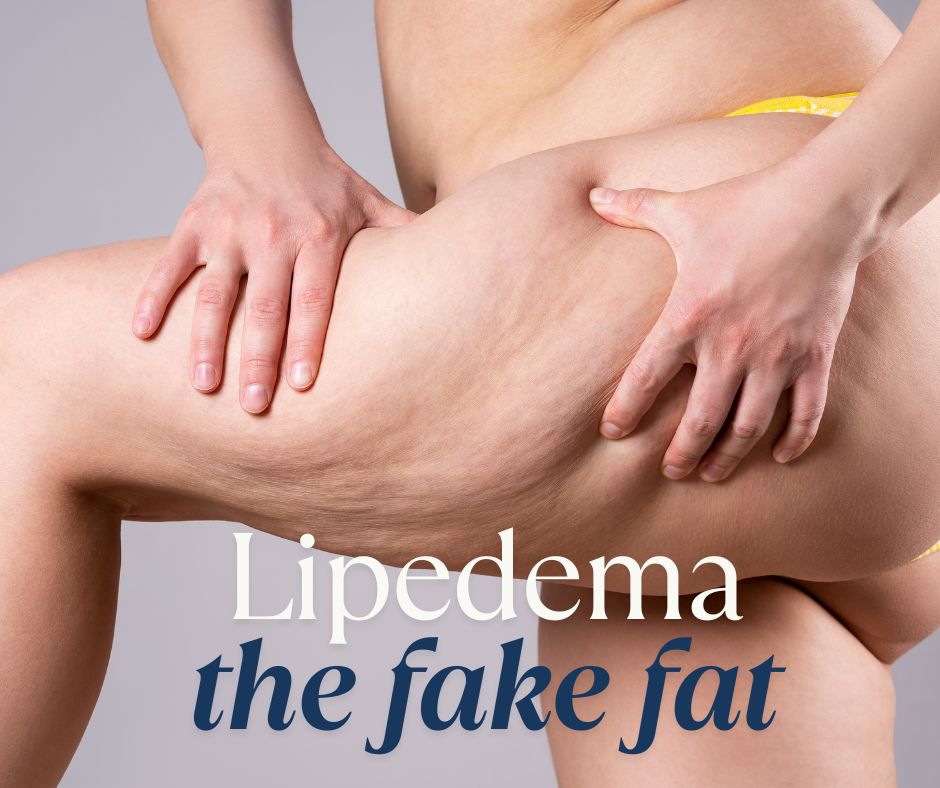Welcome! Today we’re diving into an often misunderstood women’s health condition that deserves more attention.
Understanding Lipedema: The Disease Often Mistaken for Weight Gain
Have you ever felt frustrated by stubborn fat that won’t budge despite diet and exercise? For millions of women worldwide, the issue might not be lifestyle choices but a medical condition called lipedema. This progressive disorder, which affects nearly 11% of adult women according to recent studies, is frequently misdiagnosed as simple obesity or dismissed as “just cellulite.”
Unlike regular fat tissue, lipedema fat develops almost exclusively in women, typically appearing after hormonal changes such as puberty, pregnancy, or menopause. It’s characterized by symmetrical fat accumulation primarily in the legs, hips, and sometimes arms—while the hands and feet remain unaffected.
Recognizing Lipedema: Key Signs and Symptoms
Understanding the distinctive features of lipedema can help you advocate for proper diagnosis:
🔍 Disproportionate body shape: slim upper body with larger lower body
🔍 Fat tissue feels nodular or “pebbly” to the touch
🔍 Easy bruising and tenderness in affected areas
🔍 Fat deposits are symmetrical (appearing on both sides equally)
🔍 Minimal to no fat on feet and hands (creating a “cuff” effect at ankles/wrists)
🔍 Persistent swelling that worsens throughout the day
🔍 Pain, heaviness, or discomfort in affected limbs
According to the Lipedema Foundation, women with this condition can exercise vigorously and follow restrictive diets yet see little change in affected areas. This resistance to traditional weight loss methods is a telltale sign that differentiates lipedema from obesity.

The Hormonal Connection: Why Lipedema Affects Women
Research from Stanford Medicine indicates that hormonal factors play a crucial role in lipedema development.
Estrogen appears to influence how fat cells behave in susceptible women, which explains why the condition often begins or worsens during hormonal shifts. Genetics also play a significant role—approximately 60% of patients have family members with similar symptoms.
This hormonal connection explains why lipedema is rarely seen in men and why women often report significant progression during pregnancy, perimenopause, and other times of hormonal fluctuation.
Beyond Aesthetics: The Physical and Emotional Impact
Lipedema is far more than a cosmetic concern. As it progresses through its four stages, it can cause:
• Mobility limitations due to heaviness and joint stress
• Chronic pain and tenderness
• Secondary lymphedema (lymphatic system complications)
• Gait changes and joint problems
The emotional toll can be equally devastating. Many women report years of being told to “just lose weight” by medical professionals unfamiliar with the condition. This misunderstanding contributes to feelings of shame, frustration, and helplessness.
Diagnosis: Seeking Answers and Validation
Getting diagnosed with lipedema can be challenging but is essential for proper treatment. Since there’s no single definitive test, diagnosis relies on:
• Physical examination by a knowledgeable provider
• Medical history review, particularly regarding weight changes and hormonal events
• Ruling out other conditions with similar symptoms
• Sometimes imaging studies to evaluate fat distribution patterns
If you suspect you have lipedema, seek out specialists familiar with the condition—typically lymphatic specialists, vascular surgeons, or plastic surgeons with lipedema experience.

Management Strategies: Taking Control of Lipedema
While there’s no cure for lipedema, several evidence-based approaches can help manage symptoms and slow progression:
1. Conservative Treatments
• Complete Decongestive Therapy (CDT): This specialized form of manual lymphatic drainage helps reduce fluid buildup and improve comfort
• Compression garments: Custom-fitted compression stockings or sleeves help control swelling and support affected tissue
• Specialized exercise: Low-impact activities like swimming, cycling, and walking improve circulation without taxing painful joints
• Vibrating plate: Fitness Platform Exercise Machine Vibrating Lymphatic Drainage
• Leg Massager, 3-in-1 Foot Calf & Thigh Massager with Heat and Compression
• Dry Body Brush – Natural Bristle Exfoliating Brush for Skin Renewal, Lymphatic Support and Circulation
• Lifewave X39 patches a non medica remedy that reduce pain and inflammation
2. Dietary Approaches
• Anti-inflammatory diets: Many patients report symptom improvement with Mediterranean or other anti-inflammatory eating patterns
• Ketogenic Diet this is personally the diet that changed the way I feel, reduced pain and swelling
• Reducing sodium: Limiting salt intake may help manage fluid retention
• Avoiding trigger foods: Some women find that certain foods (especially refined carbohydrates) worsen their symptoms
3. Surgical Options
For advanced cases, specialized surgical techniques can provide relief:
• Liposuction: Not cosmetic liposuction, but specialized water-assisted techniques like WAL (Water-Assisted Liposuction) that preserve lymphatic vessels.
It is really important to understand that this is not a classic liposuction only doctors specialize in LIPEDEMA they can perform it!
A regular liposuction wouldn’t help, and in some cases would make the situation worse.
• Lymph-sparing procedures: Surgeries designed to remove lipedema fat while protecting the lymphatic system

Finding Support: You’re Not Alone
Living with lipedema can feel isolating, but supportive communities exist both online and in person. Organizations like the Lipedema Project and Fat Disorders Research Society offer resources, provider directories, and connection with other patients.
Support groups (I have found many on Facebook) can provide not only emotional validation but practical advice on finding knowledgeable medical professionals, insurance coverage strategies, and day-to-day management tips.
You can find more information in these books
- The Essential Guide To Living With Lipedema:
- Lymphedema and Lipedema Nutrition Guide: foods, vitamins, minerals, and supplements
- Lipedema – The Disease They Call FAT
Advocating for Yourself: Navigating Healthcare
Because lipedema awareness remains limited in the medical community, self-advocacy is essential:
• Educate yourself about the condition using reliable sources
• Bring information to appointments (especially medical journal articles)
• Document your symptoms with photos and symptom journals
• Be persistent in seeking proper evaluation
• Consider telehealth consultations with lipedema specialists if none are available locally
Hope on the Horizon: Research and Recognition
The good news is that lipedema research is advancing. The National Institutes of Health has recognized lipedema as a distinct medical condition, and research funding has increased substantially in recent years. Clinical trials are underway exploring treatments ranging from anti-inflammatory medications to specialized surgical approaches.
Greater recognition is leading to improved diagnostic criteria and treatment protocols, giving hope to the millions of women affected by this condition.
Conclusion: From Misunderstood to Managed
Lipedema may be challenging, but understanding it is the first step toward effective management. By recognizing the distinct differences between lipedema and obesity, women can pursue appropriate treatments rather than endless cycles of restrictive dieting that won’t address the underlying condition.
If you recognize yourself in the symptoms described here, know that you deserve medical care that acknowledges the true nature of your condition. With proper diagnosis and comprehensive treatment, many women with lipedema find significant improvement in both physical symptoms and quality of life.
Remember: lipedema is a medical condition, not a failure—and with increasing awareness and research, better treatments continue to emerge. 💜

Do you have Lipedema? Here is the book I wish I had
If you’ve ever been dismissed by doctors or told you just need more “discipline,” read My story in Not Just Fat: The Truth About Lipedema. It’s more than a book; it’s a validation of your experience and a guide for reclaiming your health.
Can’t afford the full price? No problem — pay what you can. And if you’d like to support my work and help more women learn about lipedema, feel free to give more. Every bit helps.




